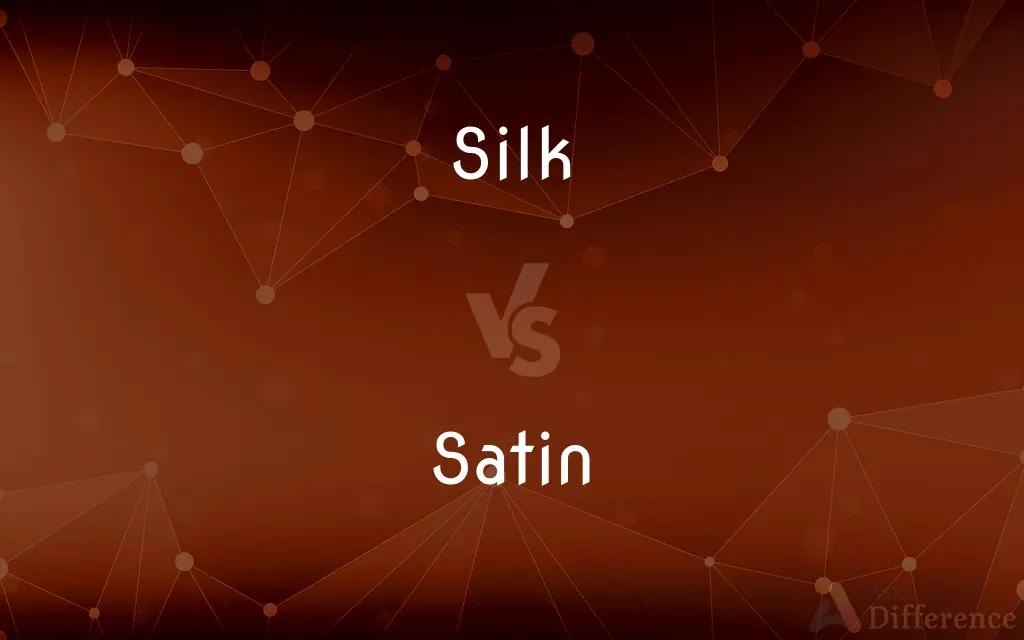Silk vs. Satin — What's the Difference?
Edited by Tayyaba Rehman — By Fiza Rafique — Updated on September 21, 2023
Silk is a natural protein fiber obtained from the cocoons of the silkworm. Satin is a weave pattern that can be made from various materials, including silk, to create a smooth, glossy fabric. Silk refers to the fiber, whereas satin refers to the weave.

Difference Between Silk and Satin
Table of Contents
ADVERTISEMENT
Key Differences
Silk is a natural fiber that is produced by the silkworm. It is known for its smooth texture and natural luster. The term "silk" primarily refers to the material itself, which can be used to create various types of fabrics, including satin.
Satin, on the other hand, is not a material but rather a type of weave. The satin weave creates a fabric that is glossy on one side and dull on the other. This weave can be accomplished using a variety of fibers, including silk, polyester, and nylon.
Silk often serves as the premium fiber used in creating high-quality satin fabric because of its natural sheen and smoothness. However, it is crucial to note that not all satin is made from silk. Many satins are made from synthetic fibers like polyester, which mimic the look of silk but do not offer the same natural qualities.
Satin made from silk combines the best of both worlds: the natural luster of silk and the glossy finish achieved by the satin weave. However, the two terms should not be used interchangeably, as silk refers to the type of fiber, while satin refers to the type of weave.
Comparison Chart
Nature
Natural fiber
Weave pattern
ADVERTISEMENT
Material
Produced by silkworms
Made from various fibers
Texture
Smooth
Glossy on one side, dull on the other
Common Uses
Various fabrics, including satin
Dresses, linings, sheets
Cost
Generally expensive
Cost varies by material used
Compare with Definitions
Silk
Used in a variety of luxury products.
The silk sheets added a touch of elegance to the bedroom.
Satin
A fabric made using a satin weave.
Her satin dress shone in the evening light.
Silk
Biodegradable and natural.
I prefer silk because it's a sustainable option.
Satin
Commonly used in formal wear.
He wore a satin bow tie to the wedding.
Silk
Known for its smooth texture and luster.
He wore a silk tie to look more professional.
Satin
Known for its draping quality.
The satin curtains draped beautifully, adding a touch of luxury.
Silk
A natural protein fiber produced by silkworms.
The silk scarf felt incredibly smooth against her skin.
Satin
Glossy on one side, dull on the other.
The satin fabric had a beautiful sheen on one side.
Silk
Silk is a natural protein fiber, some forms of which can be woven into textiles. The protein fiber of silk is composed mainly of fibroin and is produced by certain insect larvae to form cocoons.
Satin
A satin weave is a type of fabric weave that produces a characteristically glossy, smooth or lustrous material, typically with a glossy top surface and a dull back. It is one of three fundamental types of textile weaves alongside plain weave and twill weave.
Silk
A fine lustrous fiber composed mainly of fibroin and produced by certain insect larvae to form cocoons, especially the strong, elastic, fibrous secretion of silkworms used to make thread and fabric.
Satin
A smooth, often silk fabric that is woven with a glossy face and a dull back.
Silk
Thread or fabric made from this fiber.
Satin
A garment made of this fabric.
Silk
A garment made from this fabric.
Satin
A kind of paint that dries to a smooth shiny finish.
Silk
A silky filamentous material spun by a spider or an insect such as a webspinner.
Satin
Made of or covered with satin.
Silk
A silky filamentous material produced by a plant, such as the styles forming a tuft on an ear of corn.
Satin
Glossy, sleek, and smooth.
Silk
Silks The brightly colored identifying garments of a jockey or harness driver.
Satin
A cloth woven from silk, nylon or polyester with a glossy surface and a dull back. (The same weaving technique applied to cotton produces cloth termed sateen).
Silk
Composed of or similar to the fiber or the fabric silk.
Satin
Semigloss.
Satin paint
Silk
To develop silk. Used of corn.
Satin
(transitive) To make (paper, silver, etc.) smooth and glossy like satin.
Silk
A fine fiber excreted by the silkworm or other arthropod (such as a spider).
The thread made of silk was barely visible.
Satin
A silk cloth, of a thick, close texture, and overshot woof, which has a glossy surface.
Cloths of gold and satins rich of hue.
Silk
A fine, soft cloth woven from silk fibers.
Satin
A smooth fabric of silk or rayon; has a glossy face and a dull back
Silk
Anything which resembles silk, such as the filiform styles of the female flower of maize, or the seed covering of bombaxes.
Satin
Can be made from various materials, including silk.
The satin was actually made from polyester.
Silk
The gown worn by a Senior (i.e. Queen's/King's) Counsel.
Silk
(colloquial) A Queen's Counsel, King's Counsel or Senior Counsel.
Silk
A pair of long silk sheets suspended in the air on which a performer performs tricks.
Silk
The garments worn by a jockey displaying the colors of the horse's owner.
Silk
(transitive) To remove the silk from (corn).
Silk
The fine, soft thread produced by various species of caterpillars in forming the cocoons within which the worm is inclosed during the pupa state, especially that produced by the larvæ of Bombyx mori.
Silk
Hence, thread spun, or cloth woven, from the above-named material.
Silk
That which resembles silk, as the filiform styles of the female flower of maize.
Silk
A fabric made from the fine threads produced by certain insect larvae
Silk
Fibers from silkworm cocoons provide threads for knitting
Silk
Sensitive to sunlight and water stains.
Be careful not to spill anything on your silk blouse.
Common Curiosities
What is silk?
Silk is a natural protein fiber produced by silkworms.
Why is silk expensive?
Silk is labor-intensive to produce and is considered a luxury material.
Does silk breathe well?
Yes, silk is breathable and can regulate temperature.
How are silk and satin different?
Silk is a type of fiber, while satin is a type of weave.
Is satin expensive?
The cost of satin varies depending on the material used in the weave.
Where is silk commonly used?
In clothing, home furnishings, and various fabrics.
Is satin always made from silk?
No, satin can be made from various fibers including polyester and nylon.
Is silk vegan?
No, silk production involves the use of silkworms.
Is satin breathable?
Satin's breathability depends on the fibers used.
What is satin?
Satin is a type of fabric weave that produces a glossy surface.
Can I use silk and satin interchangeably?
No, they refer to different things: silk is a fiber, satin is a weave.
Can satin be vegan?
Yes, if made from synthetic fibers like polyester.
Where is satin commonly used?
In formal wear, linens, and upholstery.
How do you clean silk?
Silk is often dry-clean only due to its delicacy.
How do you clean satin?
Cleaning methods vary depending on the fiber used.
Share Your Discovery

Previous Comparison
Connotation vs. Denotation
Next Comparison
Pneumologist vs. PulmonologistAuthor Spotlight
Written by
Fiza RafiqueFiza Rafique is a skilled content writer at AskDifference.com, where she meticulously refines and enhances written pieces. Drawing from her vast editorial expertise, Fiza ensures clarity, accuracy, and precision in every article. Passionate about language, she continually seeks to elevate the quality of content for readers worldwide.
Edited by
Tayyaba RehmanTayyaba Rehman is a distinguished writer, currently serving as a primary contributor to askdifference.com. As a researcher in semantics and etymology, Tayyaba's passion for the complexity of languages and their distinctions has found a perfect home on the platform. Tayyaba delves into the intricacies of language, distinguishing between commonly confused words and phrases, thereby providing clarity for readers worldwide.














































